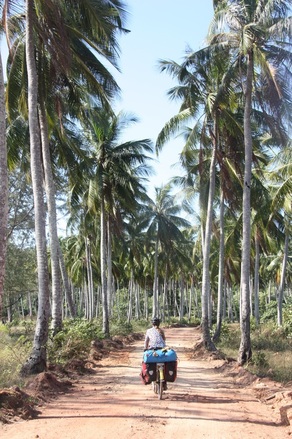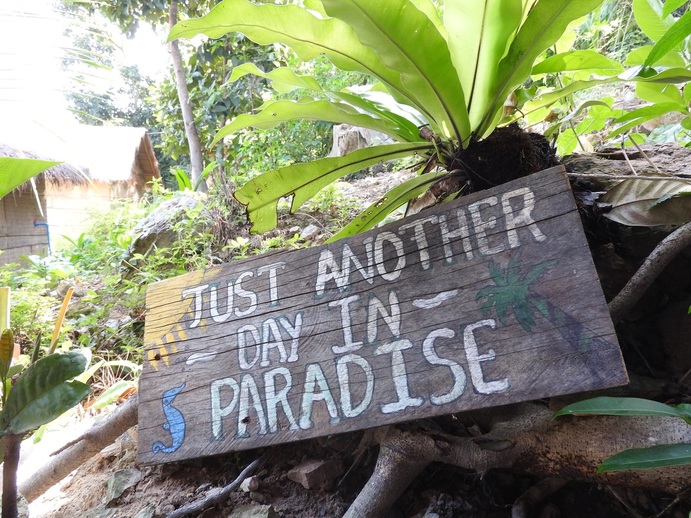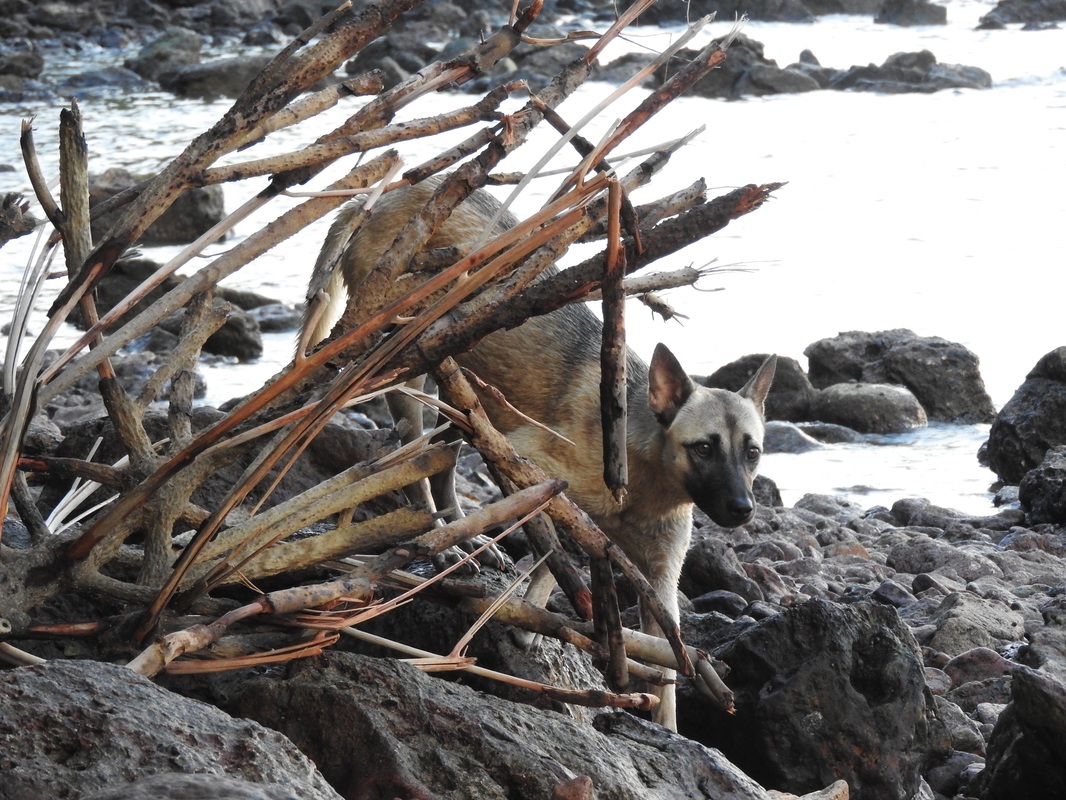
It was refreshing to be back on the bicycles after residing on a tiny island for over a month, so much so that we took an ambitious day ride to the top of Bokor Mountain on Christmas Eve. It was incredible to see the influence of elevation on nature as tropical forest featuring hornbills and gibbons gave way to foggy scrubland towards the chilly upper reaches of the oversized hill. It was strange to gaze down through breaks in the clouds to the sweaty flatlands 4,000 feet below. Even stranger still was the incongruent assortment of development capping the mountain. Originally a French Hill Station where the colonists would retreat from the lowland heat and humidity, many of the buildings later served as refuge from the enemy as Khmer Rouge and Vietnamese forces duked it out. We explored the shell of a once luxurious casino and a church that had been occupied by the opposing forces.
Then, in stark contrast to the historical sites, we locked up our bikes in the corner of an expansive, multi-tiered, but completely empty parking lot, the likes we have not seen since leaving Suburbia USA. We wandered in to a massive casino hotel that would not look out of place in Vegas, except for the surprisingly small casino itself and the modestly dressed staff. While all of this felt oddly out-of-place for Cambodia, what really made us wonder what bizarre world we had stumbled upon was the Christmas festivities in the form of poorly executed gingerbread houses with styrofoam trimmings and Khmer employees awkwardly dressed as Santas and elves. If all of this doesn't sound so weird to you, consider that Cambodia is a poor, predominantly Buddhist country, so commercialized Christmas decorations are essentially non-existent there.
We weren't really sure what clientele Thansur Bokor Highland Resort was targeting, either with the Christmas gimmicks or with building the ridiculous resort in the first place. However, one thing was for sure. After "leasing" the entirety of Bokor National Park from the Cambodian government for 99 years, the Chinese-owned parent company Sokimex Group constructed what has to be the nicest and smoothest road in all of Cambodia in order to whisk guests straight to the casino's grand entrance. The national park signs have all been removed, so you would never know you were technically in a national park (unless of course you knew). Now with a full dose (overdose?) of "Christmas spirit" and the privatization of public land, we took full advantage of that pristine pavement to fly down the mountain in a fraction of the hours it took to huff our way to the top.
Sadly, Bokor National Park is just one example of the trend of auctioning off of national parks to major developers as Cambodia's leaders seek to make the elite even richer in order to stay in power. For China in particular, Cambodia has recently become an alluring land of investment opportunities. The Thansur Bokor Highland Resort claims to be stewarding the park by providing increased enforcement personnel to patrol against illegal logging and poaching of the forest's many endangered species. On the other hand, they are depleting habitat with plans for a golf course, cable car, and water park, not to mention planting a monoculture of thousands of non-native trees to "complement the beauty" of the resort.
On Christmas Day, we celebrated with an evening boat cruise up the Praek Tuek Chhu River. We enjoyed the perspective of watching the sun set behind Bokor Mountain since we had just cycled up there the day before. However, the best part was seeing synchronized fire flies for the first time once it was fully dark. The insects tended to rest on vegetation instead of flying around, so large patches of trees and shrubs were covered with coordinated blinking. Appropriately, they really looked like twinkling Christmas lights!
The next day, we packed up and said goodbye to Kampot. Since it had been a few days since we had seen the ocean, we aimed for Ream Beach on the border of Ream National Park. The last few miles of riding were slow going on a rocky sandy track in the dark, but that only made our destination of Monkey Maya Hostel feel that much more remote and special. Fortunately, the dorm was full, as were the well-above-our-budget bungalows, so the owners were amenable to having us pitch our tent next to the beachside volleyball court. At dinner they introduced us to another cycling couple from Germany who had quite an adventure arriving to Monkey Maya earlier that morning. They had followed a road cutting through the national park, only to have it worsen and eventually disappear as it approached the coast. Once it was dark, they ended up sleeping on a random beach without camping gear or food while their reserved bungalow at Monkey Maya awaited them. In the morning, they pushed their bikes along the rocky coastline only to discover they had slept only 800 meters away from their goal!
Very smartly, Monkey Maya offers a free beer to anyone who collects a rice sack of garbage off of the beach. Consequently, this was easily the cleanest beach we have seen our journey. Of course, when duty calls to drink free beer, we can be counted on. So we wiled away the day by picking the micro-trash out of the beautiful white sand that others skip over in an effort to fill their bags quickly, and dipped in the calm water when we got too sweaty. The isolation of the place induced relaxation, but that gave us space to contemplate our unstructured future, which led to a heated "discussion" over our hard-earned free beer with a stunning sunset backdrop. Matt commented, "Only we can find a way to make such a beautiful place so depressing." Nonetheless, we were grateful to have visited this newly "discovered" beach. We saw evidence that it is only a matter of time until other developments come in, and chances are high that they won't be as sensitivity-designed or responsibly-operated as Monkey Maya.
Things were easier in the morning as we became refocused on our short term plan of cycling to Otres Beach. The main area of "Otres 1" had a Wild West meets the beach feel to it with an eclectic range of establishments lining a rutted, bumpy, red dirt road. We got what we needed--lunch and info on boats to Koh Ta Kiev--and got out, retreating to more chill and inexpensive "Otres Village" set back from the beach. Although we didn't know it at the time, and neither did the place itself, Otres 1 qualified for "before it's gone" status. It may already be gone as I write this as government officials abruptly ordered the beachfront establishments to move off of the beach. Beaches are public property after all, unless of course you have deep pockets and know the right people. While it may be a seemingly arbitrary and ultimately discriminatory enforcement of the law, I don't see it as any great loss of an amazing place, although your average backpacker of Southeast Asia is certain to be heartbroken. However, given the choice, I would take a backpacker haven with laid-back independent businesses any day over another "soulless mega-resort," which is widely speculated to be the motivation of the sudden eviction notices.
The next morning we took a boat out to Koh Ta Kiev, one of the few islands in the Sihanoukville area not (currently) slated for exclusive luxury resort ruination. The boat dropped us off at our intended camping spot at The Last Point which we quickly concluded was no longer our intention. People had raved about this island and insisted that we go there, but our first impression was a non-existent beach with a surfline filled with litter and torn up sea grass. We knew we could do better and the hungover staff didn't mind in the least pointing out a trail through the forest to the other side of the island. The next spot of Coral Beach was buzzing and definitely the hip place to be on the island. We balked at the $25 rate for an otherwise enticing stilted bungalow and they were firm on the no camping policy. We had a similar experience at the next one down the beach called Ten103. We were almost ready to settle for an uninspiring but cheap shack, though at the most authentically Khmer establishment thus far--KTK Bungalows. Luckily, my stubborn thoroughness kicked in despite my exhaustion from being hit with a food-related stomach bug in the middle of the previous night. The last option, Crusoe Island, was rumored to be closed back on the mainland or we would have taken a boat directly to it in the first place. But what we found was fully operational and pretty close to perfect. However, we did appreciate our "discovery" even more after having walked the length of the island and investigated all other options. That method of multi-hour exploration wouldn't have been so bad if it weren't for the loose sand with loaded backpacks in the mid-day heat while I suffered waves of nausea and cramps.
We began our Crusoe fantasy by staking down our tent for $2 per night on a rocky outcrop just above the high tide line with no other campers in sight. It was a short walk down the beach to the unexpectedly amazing restaurant and creatively designed hang out area. So then it was no surprise that we decided to stay a couple of extra days. We were so enamored with the place that we even offered to step in as the next round of volunteer staff for an extended stay, but the nice Khmer lady who owns it already had enough help for the foreseeable future.
In keeping with tradition, we had a mellow New Year's Eve and fell asleep by ten to the bumping and thumping of concerts across the bay at Otres and Sihanoukville. A night swim amongst abundant bioluminescent plankton was the only fireworks show we needed to see anyway. It was an ideal last beach experience for the foreseeable future as our route would take us away from the immediate coastline after we returned to the mainland.



 RSS Feed
RSS Feed
